Keywords
|
| Online Buying Behavior, Internal and External Variables, Simple and Multiple Linear Regression Model, Construct Analysis, Middle East |
INTRODUCTION
|
| The internet has been perceived by consumers in different dimensions viz. Communication, Information and business medium. Numerous research studies revealed the intention of consumers to use internet as information and business medium (Goldsmith and Bridges, 2000; Goldsmith, 2001; Goldsmith, 2002; UCLA, 2000, 2001, 2003). The rapid emergence of internet in today’s’ business and commerce cannot be denied as the same is used by corporate world for different purposes. The internet bridges the physical divide through digital connectivity, thus enabling consumers to collect information, do evaluation and make online or offline purchase (Sakkthivel, 2002). The Internet plays a predominant role in today’s business and commerce. Corporate world use the internet for different aspects viz. communication, business, connectivity, relationship with target consumers (Sakkthivel, 2006). The internet has metamorphosed from the role of communication media to business media in recent days which witnessed a tremendous spur in online purchase of different products (Sakkthivel, 2009). |
| Numerous companies dealing with products/services use the internet a vital medium to reach target consumers in order to communicate, convince and enable them to make purchase. The internet is become a major lexicon of marketing strategies of leading companies and conglomerates across the world. It plays a major role in designing marketing strategies and achieving success in attaining so. Consumers use the internet for different activities such as collecting information, evaluation of the information/specifications/prices etc. and buying different products/services (based on investment and involvement) online (Sakkthivel, 2010). However, it is imperative to study the online behavior of consumers with reference to the impacting variables on such behavior. In this regard, the researcher intends to conduct an exploratory to identify the impacting variables (internal) and external variables on online buying behavior of consumers. |
| The study is unique and novel as it focused on the major variables that influence online consumer behavior into two major categories such as internal and external. The researcher developed the aforesaid constructs based on the controllability of the variables by a company. Therefore, the two major constructs viz. internal variables i.e. controlled and managed by companies and external variables i.e. beyond the control and management of companies with reference to identifying the impact of such variables on online consumer buying behavior. The internal and external variables consist of several aspects viz. internal variables (product, price, promotion, distribution, design of website, secured payment gateway, Buyback Assurance, easy to buy) that are primarily controlled and managed by companies, and external variables (influence of peer groups, opinion groups, culture, society, brand reputation, country of origin, reliability of websites, previous experience) that are beyond the control and management of companies involve in using internet as business media. |
| The study would focus on identify the impact of the aforesaid variables on online buying behavior of consumers from Middle Eastern Countries. The rationale behind the selection of such environment is to expose the online buying behavior of consumers as the markets witnessed a tremendous spur in usage of internet in recent days. The study attempted to provide a holistic view of variables influencing online buying behavior. The study also intended to provide appropriate insights to the companies targeting Middle East with reference to the impacting variables on the online consumer behavior. The market is moving from nascent to growing, in terms of making online purchase. Hence, the study would act as a precursor to the companies in understanding the expectations of the online users. Therefore, the outcomes of the study would intend to contribute valuable inputs to the existing literature with regard to influence of the selected variables on online buying behavior |
IMPACT OF INTERNAL VARIABLES ON ONLINE BUYING BEHAVIOR
|
| Bruno (1997) observed that the Internet has been used to facilitate online sales such as it acts as a means of communication about the companies sell product/services online/offline (information and communication media as it extends consumers ability to procure maximum information at their door step). The numerous research studies had been conducted to study the consumer Internet behavior as e-commerce grows in size and gaining significance and consumer researchers ought to take more effort to studying consumer Internet behavior on how consumers make the Internet a part of their consumption (Peterson, et al., 1997; Cowles and Kiecker, 2000). The numerous studies observed that the E-commerce managers/companies need to understand the factors influence consumers buy online, so that they can develop effective strategies to encourage consumers to their web sites to spend time and money (Aldridge et al., 1997; Wysocki, 2000). |
| The studies conducted by numerous researchers found that the consumer online behavior has shown that attitudes toward the Internet and toward online buying are systematically related to online buying behavior. (Katz and Aspden, 1997; Eastlick and Lotz., 1999; Goldsmith and Bridges, 2000; Karson, 2000). The studies by Modahl (2000) and Murphy (2000) observed that most of the researches on Consumer Internet Behavior have normally been descriptive in nature, focusing on gathering statistical information on products/services online and the demographic profile or characteristics of online buyers in order to give a glimpse of online consumer profile. Degeratu et al (2000) conducted a study to identify the influence of price on online buying behavior. They also explored the impact of price sensitivity and price discounts on online purchase intentions. |
| Kwak et al (2002) identified that consumers who frequently seek product information online are more likely to engage in web purchasing. This trend is confirmed through overall purchase and all nine individual product categories. It vividly portrays the acquiring information about products/services over Internet is the positive approach that consumers exercise towards the Internet which may likely to turn out to be future purchase. Kwak et al (2002) found from his study that 43.6 percent of consumers bought online and 31.6 percent bought computer related products and services, 26 percent bough books, information and magazines etc. It revealed that the consumers buy high and low involvement products online. TNS (2002) identified that most of Internet buyers in India prefer to buy CDs, Music, Books, Travel booking, holiday package online. Brown et al (2003) identified the influence of product type of online purchase intentions. |
| Chevalier and Goolsbee (2003) explored the possibilities of price sensitivity in affecting business prospects of online business through a comparative analysis between Amazon and BarnesandNoble. Kim and Kim (2004) explored the online consumer behavior towards buying clothing products online and found several variables impacting the same. Jiang and Rosenbloom (2005) conducted a study that identified the price influence to online buying behavior and intention to purchase more. Bosnjak and Galesic (2007) observed the intentions of retailers to use websites as profitable channels of distribution to reach and sell products/services online. Moon et al (2008) involved in a study to find the influence of product and price on online purchase. Kwak et al (2008) discussed the influence of media on online consumer behavior. Sakkthivel (2009) conducted a study to identify the impact of demographics on consuming different products online and found the age and income had significant impact on buying different products online. Sakkthivel (2010) conducted a study to identify the intention of consumers to purchase products/services online. Fagerstrom and Ghinea (2011) explored the possibilities of price motivation and online recommendations during the online purchase and found the significant impact of price variations on online purchase. The aforesaid studies emphasized the necessity of exploratory research in order to identify the consumer behavior towards buying different products and services online. |
| H1: There is a significant Impact of Internal Variables (Product, Price, Promotion, Distribution, Website/Portal Design, Secured Payment Gateway, Buyback Offer/Assurance, Easy to Buy (Procedures)) on Online Buying Behavior |
IMPACT OF EXTERNAL VARIABLES ON ONLINE BUYING BEHAVIOR
|
| Feather (2000) identified that those who use the Internet more are likely to buy more online than those who use it less and providing logic of more usage of Internet might induce consumers to gain more exposure which might lead to more trust over Internet activities. This might be the earlier stage of exercising purchase behavior over Internet by collecting information as the consumer believed the reliability of the information available over Internet. Seckler (2000) observed that the consumers those who gained experience with online buying with a small purchase at the earlier stage will likely to develop confidence and skills that facilitate more ambitious purchase. It clearly shows that the more experience will install trust in consumers to buy expensive products over Internet. |
| Degetratu et al (2000) involved in a study to observe the influence of brand name on online consumer buying behavior. Reliability of websites in providing information, enabling evaluation and purchase had significant influence over online buying behavior (UCLA, 2000; UCLA 2003). Novak et al (2002) attempted a study to identify the influence of customer experience on online purchase. Heijden et al (2003) observed the impact of ease of use on online purchase. Brown et al (2003) conducted a study that identified the impact of prior purchase/experience on online buying behavior. Kim and Kim (2004) conducted a study that found the influence of site design on online purchase intentions. Thompson and Yuanyou (2005) observed in their studies that the consumers intend to buy online when they have trust on the online stores. This has reflected the reliability of information and evaluation of different products and services online would instill the trust among the consumers to buy online. |
| Jiang and Rosenbloom (2005) observed the influence of achieving satisfaction over online purchase on the future purchases. It vividly shows the experience gained from the previous purchases impacting future purchases. Lim et al (2006) involved in a study to indentify the influence of peer groups on online purchase and found the local/non foreign peers enjoyed significant influence on online buying behavior. There were studies conducted to identify the influence of reference groups on online purchase (Fong and Burton, 2006a: Fong and Burton, 2006b). Dinev et al (2006) observed the influence of culture on online purchase through comparison of Italy and US consumers. Solo and Karjaluoto (2007) observed the influence of society and culture on online shopping. Zhou et al (2007) conducted an extensive review of studies related to the influence of society and culture on online purchase. Tan et al (2007) conducted a study to find the impact of peer influence and external influence on online shopping behavior. Moon et al (2008) involved in a study to find the influence of culture on online purchase. Brunelle (2009) attempted a study to find the impact of online stores on online customer intentions to make purchase. Kozinets et al (2010) observed the influence of word-of-mouth influence on online purchase which might referring to the influence of peer and reference groups. |
| H2: There is a significant Impact of External Variables (Influence of Peer groups, Reference, Culture, Society, Country of Origin, Reliability of Websites/Trust, Previous Experience, Brand Reputation) on Online Buying Behavior |
| The aforesaid literature provided a much needed cue to the problem definition. However, none of the studies attempted on a study to identify the impact of the aforesaid variables selected on online buying behavior. Moreover, none of the studies attempted to identify the variables that are controlled by a company on online buying behavior. Hence, it adds the novelty and uniqueness to the problem selected. There were several variables selected for the study such as buyback offer/assurance, previous experience etc. have not been well researched. Hence, the study would attempt to identify the impact of the aforesaid variables on online purchase. Therefore, the study would attempt to bring such gaps identified and provide a holistic view on the variables that are controlled by a company. It is pertinent to state that the study would provide a much needed direction to the academia and practicing mangers and provide a significant contribution by the study to the existing literature. |
CONCEPTUAL MOTIVATION
|
| Fig 1 describes the formulation of research model or conceptual motivation proposed to be identified through the problem defined for the study. |
| The aforesaid conceptual model has been proposed to identify the impact of the selected variables on online buyer behavior. The authors defined the constructs with suitable variables for each construct. Internal variables (controllable by a company) consist of product, price, promotion, distribution, website/portal design, secured payment gateway, buyback offer/assurance, Easy to buy (procedures) etc. External variables (beyond the control of a company) consist of influence of peer and reference groups, culture, society, country of origin, reliability of websites/portals, previous experience, brand reputation etc. The aforesaid variables constitute the constructs selected for the study. Detailed explanation of construct development is given below (Table 1 and 2). |
Construct development
|
| The researchers selected two major constructs viz. Internal variables i.e. product, price, promotion, distribution, website/portal design, secured payment gateway, buyback offer/assurance, Easy to buy (procedures) etc and External variables i.e. influence of peer and reference groups, culture, society, country of origin, reliability of websites/portals, previous experience, brand reputation etc.. in order to test the impact on the same on online buying behavior. The Cronbach’s Alpa reliability analysis has been done to validate the constructs (Rajagopal, 2008). The table 1 denotes the variables used to development of constructs selected for the study |
| Table 2 denotes the reliability statistics (Cronbach’s Alpa) of the constructs selected for the study. The aforesaid results clearly indicate the conformity of the variables selected for the study. |
METHODOLOGY
|
| The study used the exploratory, experimental and causal research design as it explores and intends to identify the impact of internal (controllable by a company) and external variables (beyond the control of a company) on online buyer behavior. The study was conducted among consumers residing in selected cities of Oman viz. Muscat, Sur, Nizwa, Salalah, Sohar etc. which represent the target population selected for the study. The study was conducted among the respondents represent different demographic profiles viz. age, marital Status, literacy, occupation, employment status, income, family size, place of living. The quota sampling technique has been used to collect primary data from the target respondents based on the occupation age, marital Status, literacy, occupation, employment status, income, family size, place of living). |
| The primary data had been collected from 181respondents and finally 168 (N=168) respondents had been selected for the analysis. Structured questionnaire had been used to collect the response from the target respondents. The questionnaire consists of the 18 statements related to the constructs (internal variables) and 12 statements related to external variables. 5 point likert scale (strongly agree….strongly disagree) has been constructed in order to identify the impact of the selected constructs on online buyer behavior. The collection tool has been translated to local language (Arabic) in order to ensure the respondents understand and respond to the queries. It ensures the face validity of the study. |
| Simple and Multiple Linear Regression Model had been used to identify the impact of the selected constructs on the online buyer behavior. The Model also used to check the consistency and model fit of the constructs selected. Construct analysis Modeling. (Sakkthivel, 2011b; Sakkthivel and Sriram, 2012) has been used to identify the high and low impact variables that influence online buyer behavior. Cornbach’s Alpa Reliability Analysis had been conducted to test the validity of overall collection instrument which produced .850 and attitude scale secured .885 which proved highly reliable. |
ANALYSES AND DISCUSSIONS
|
| We used simple linear regression analysis to test the impact of the each independent variable i.e. internal and external variables on online buyer behavior (Table 3 and 4). In order to estimate the impact of selected variables on online consumer buying behavior, following model is specified. |
| Yi = f(X1) where: |
| Yi = Influence on online buying behavior with respect to independent variables. |
| X1 = Impact value of internal variables that influence online consumer buying behavior |
| It is evident from the aforesaid results, the selected variables that have considerably higher impact with 73.7 percent (R2 = 0.737, p< 0.001) with reference to influence online consumer buying behavior. It is identified that the all the variables selected for the study, R2 are relatively closer to 1, as they have considerably higher impact in (Yi) influencing online buying behavior. Hence, it is evident that the variables selected for the study are consistent and fit with the model proposed for the study. The results discussed are consistent with H1. |
| In order to estimate the impact of selected variables on online consumer buying behavior, following model is specified. |
| Yi = f(X1) where: |
| Yi = Influence on online buying behavior with respect to independent variables. |
| X1 = Impact value of external variables that influence online consumer buying behavior |
| It is evident from the aforesaid results, the selected variables that have considerably higher impact with 80.6 percent (R2 = 0.806, p< 0.001) with reference to influence online consumer buying behavior. It is identified that the all the variables selected for the study, R2 are relatively closer to 1, as they have considerably higher impact in (Yi) influencing online buying behavior. Hence, it is evident that the variables selected for the study are consistent and fit with the model proposed for the study. The results discussed are consistent with H2. |
| In order to test the consistency and model fit of the constructs selected, we did multiple regression analysis |
| Yi = 0.117 + 0.527X1 + 0.527X2 |
| The above analysis shows that all the variables are highly consistent with 98.1 percent (R2 = 0.981, p < 0.001). This shows that regression equation is highly linear with respect to selected independent variables |
| It is evident from the aforesaid results; the independent variables selected for the study have very high significant impact on the dependent variable i.e. online consumer buying behavior. It is identified that the external variables relatively higher impact on online buying behavior than that of internal variables. Hence, it may be inferred that the online buying behavior is highly influenced by external variables. |
| It is evident from the aforesaid results, the independent variables selected for the study have highly significant impact on the dependent variable i.e. internal and external variables have higher significant impact over online buyer behavior (Figure 2). Though, the aforesaid model reveals the consistency and model fit of the constructs taken for the study, it is imperative to identify the high to low impact variables on online buyer behavior. Therefore, construct analysis modeling (Sakkthivel, 2011b) has been used to identify the variables that would have high to low impact on online purchase. |
Construct Analysis modeling to identify the high to low impact variables on online buying behavior
|
Modeling the internal variables impact online buying behavior
|
 |
| f(IVi) = Impact of internal variables on online consumer buying behavior |
| Si = Agreement level score of the respondents towards the influence of internal variables |
| Cj = Sum of Constructs score |
| Cn = No. of constructs taken |
| The above modelling produced the following results of the constructs have high to low impact of internal variables on online buying behavior (high to low value). ‘i’ denotes the agreement level score, ‘j’ denotes the sum of constructs score, and ‘n’ denotes the number of respondents and number of constructs taken for the study and analysis. The construct analysis has been developed to identify the influence of the selected constructs/variables on the respondents. The no. of questions asked has been grouped into constructs such as internal variables i.e. Product, Price, Promotion, Distribution, Website Design, Secured Payment Gateway, Buyback Offer, Easy to Buy etc. Those scores arrived from the constructs in terms of mean value would be interpreted according the highest to the lowest value. The values would be provided ranks as 1,2,3…n. The highest score denotes the highest impact on online consumer buying behavior and so on. The sum of the mean values of constructs has been divided by the no. of constructs selected for the study, and the mean value arrived will be considered midpoint. The mean value of the constructs above the midpoint will be considered high impact variables and vice versa. |
| The above modeling reveals that Secured Payment Gateway secured (3.81) 1st Rank, Price variables secured (3.73) 2nd rank with regard to influencing online consumer buying behavior, Product secured (3.72) 3rd rank, Promotion variables bagged (3.69) 4th rank, Easy to Buy (Procedures) earned (3.68) 5th Rank, Website Design secured (3.62) 6th Rank, Distribution bagged (3.45) and finally, Buyback Offer secured the last spot i.e. 8th Rank, in influencing online buying behavior. It is inferred from the aforesaid results, the secured payment gateway secured the top position as it is very vital for to win the trust among online consumers in order to ensure the safe and secured transaction, followed by, price, yet another important variable that influence online consumer behavior. Hence, it is evident from the study that the secured payment gateway secured the Top of Mind (TOM) position among the target respondents with reference to influencing online consumer buying behavior. Further analysis done to identify the high to low impact of internal variables on online consumer behavior and found the secured payment gateway, price, product, promotion, easy to buy (procedures) and website design enjoyed a high impact, whereas, distribution and buyback offer elicit a low impact in influencing online buying behavior. Therefore, the study revealed that secured payment, price, and product are the top internal variables enjoyed the high impact over online buying behavior. |
Modeling the external variables impact online buying behavior
|
 |
| f(EVi) = Impact of external variables on online consumer buying behavior |
| Si = Agreement level score of the respondents towards the influence of external variables |
| Cj = Sum of Constructs score |
| Cn = No. of constructs taken |
| The above modelling produced the following results of the constructs have high to low impact of external variables on online buying behavior (high to low value). ‘i’ denotes the agreement level score, ‘j’ denotes the sum of constructs score, and ‘n’ denotes the number of respondents and number of constructs taken for the study and analysis. The construct analysis has been developed to identify the influence of the selected constructs/variables on the respondents. The no. of questions asked has been grouped into constructs such as external variables i.e. Peer groups, Reference groups, Culture, Society, Country of Origin, Reliability of Websites, Previous Experience, Brand Reputation etc. Those scores arrived from the constructs in terms of mean value would be interpreted according the highest to the lowest value. The values would be provided ranks as 1,2,3…n. The highest score denotes the highest impact on online consumer buying behavior and so on. The sum of the mean values of constructs has been divided by the no. of constructs selected for the study, and the mean value arrived will be considered midpoint. The mean value of the constructs above the midpoint will be considered high impact variables and vice versa. |
| The above modelling reveals that Country of Origin secured (3.86) 1st Rank, Influence of peer groups secured (3.84) 2nd rank with regard to influencing online consumer buying behavior, Previous experience of buying products/services online bagged (3.83) 3rd rank, Reliability of Websites bagged (3.82) 4th rank, Brand Reputation earned (3.69) 5th Rank, Society secured (3.40) 6th Rank, Culture bagged (3.37) 7th rank and finally, Influence of reference groups secured the last spot i.e. 8th Rank, in influencing online buying behavior. It is inferred from the aforesaid results, the country of origin secured the top position as it may be inferred that the consumers intend to buy a product/service from a specific country of origin which acts as an influence followed by, Influence of peer groups as the consumers believe in the words of the friends/relatives to buy products/services online. Hence, it is evident from the study that the country of origin secured the Top of Mind (TOM) position among the target respondents with reference to influencing online consumer buying behavior. Further analysis done to identify the high to low impact of external variables on online consumer behavior and found the country of origin, influence of peer groups, previous experience, reliability of websites, and brand reputation elicit a high impact, whereas, reference groups, culture and society elicit a low impact in influencing online buying behavior. Therefore, the study revealed that country of origin, influence of peer groups and previous experience are the top external variables enjoyed the high impact over online buying behavior (Figure 3) |
CONCLUSIONS
|
| The study had been attempted to unveil the impact of the selected variables on online buying behavior. The study selected the major constructs viz. internal variables (product, price, promotion, distribution, design of website, secured payment gateway, Buyback Assurance, easy to buy ) and external variables (influence of peer groups, opinion groups, culture, society, brand reputation, country of origin, reliability of websites, previous experience) and test the impact of the same in influencing online consumer behavior. The study revealed that the selected variables have significant impact over online buying behavior except the influence of buyback assurance and reference groups. ` |
| The study further attempted to identify high to low impact variables on online buying behavior. It is identified that secured payment gateway and price are the internal variables that have high impact and country of origin and peer groups influence are the external variables that have high impact over online buying behavior, whereas, other variables elicit low impact. Therefore, it is evident from the study that the secured payment gateway price, country of origin, and influence peer groups elicit high impact over online buying behavior. Hence, it is inferred that the certain internal and external variables do have influence over online buying behavior. With reference to finding the impact of internal variables, it is found the secured payment-gateway, price, product, promotion, easy to buy (procedures), and website design elicit a high impact on online buying behavior. Whereas, country of origin, influence of peer groups, previous experience, reliability of websites, and brand reputation are the external variables elicit a high influence over online buying behavior. With reference to identifying the low impact variables, distribution and buyback offer are the internal variables elicit a low impact, whereas, influence of reference groups culture, and society are the external variables elicit a low impact over online buying behavior. |
| It is imperative to observe that online consumers of Middle Eastern countries look for secured payment, price, country of origin of products etc to decide on online purchase. It is also to understand the distribution, buyback offer, reference groups, culture, society etc. have less influence over online purchase. It may be inferred that the online consumers are not affected by society and culture in the place where culture and society plays a vital role in deciding the life style. Hence, it may be understood that the consumers look beyond the society and culture while make buying decisions online. Looking at the control aspects of the variables chosen for the study, it is evident that both the variables (internal and external) control the online buying behavior. Therefore, the practicing managers would benefit from the insights and utilize the same with regard to designing effective marketing strategies, for achieving higher revenues, profits and customer life time value. The outcomes of the study would provide much needed cue to industry and academia and make a significant contribution to the existing literature. Given the results, the practicing managers may work an effective strategic plan to suit to the target consumers, in order to reach, influence them to buy different products that are acceptable to culture, society and family. |
LIMATIONS OF THE STUDY
|
| The researcher underwent several challenges during the research study, such as the identification of the target respondents, who could understand, emulate, and contribute to the problem definition, collection of data within the stipulated period etc. However, the researchers could identify the target respondents, who could understand and contribute to the problem definition, and successfully completed the study which was proven by reliability analysis. The users in Middle East are not yet fully exposed to online purchase, nevertheless, they fully utilize internet for different aspects through modem and mobile phones. The researcher included certain variables such as buyback offer/assurance, easy to buy (procedures) through the practices from online companies. Those variables have not been well researched yet and the study would contribute valuable inputs to existing literature. |
SCOPE OF FURTHUR RESEARCH
|
| The researcher attempted to use the major constructs viz. internal and external variables as problem definition and tested their validity through testing of hypotheses. The future researchers may focus on selecting one of the variables to do an in-depth study of such variables over consumers. Also, may choose to test the influence of such variables over selecting particular category of products/services. The variables selected have a core focus on the controlling aspects of a company on online consumer behavior towards buying products/services online. The future research may focus on the consumer focus on such variables. |
Acknowledgement
|
| The author would like to acknowledge the moral and monetary support provided by the Chairman, Dean and Board of Directors of Sur University College, Sur. The author would also acknowledge the contribution of Mr. Abdullah Al-Shaaibi in this work. |
ANNEXURE
|
Collection Tool (English)
|
(5- Strongly Agree; 4-Somewhat Agree; 3-No comments; 2-Somewhat Disagree; 1- Strongly Disagree)
|
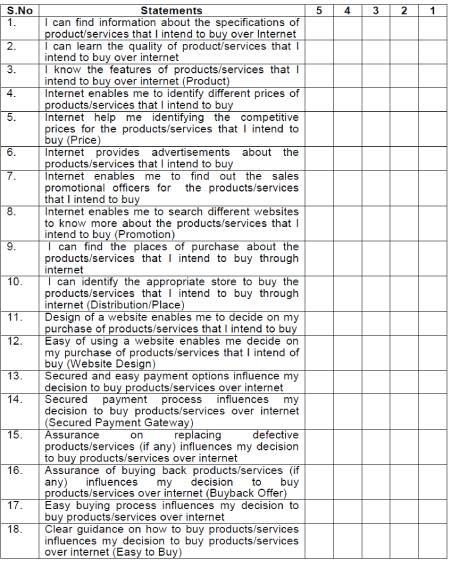 |
12) Please state your agreement on the following external factors that influence your buying and decision making behaviour towards buying products/services online
|
(5- Strongly Agree; 4-Somewhat Agree; 3-No comments; 2-Somewhat Disagree; 1- Strongly Disagree)
|
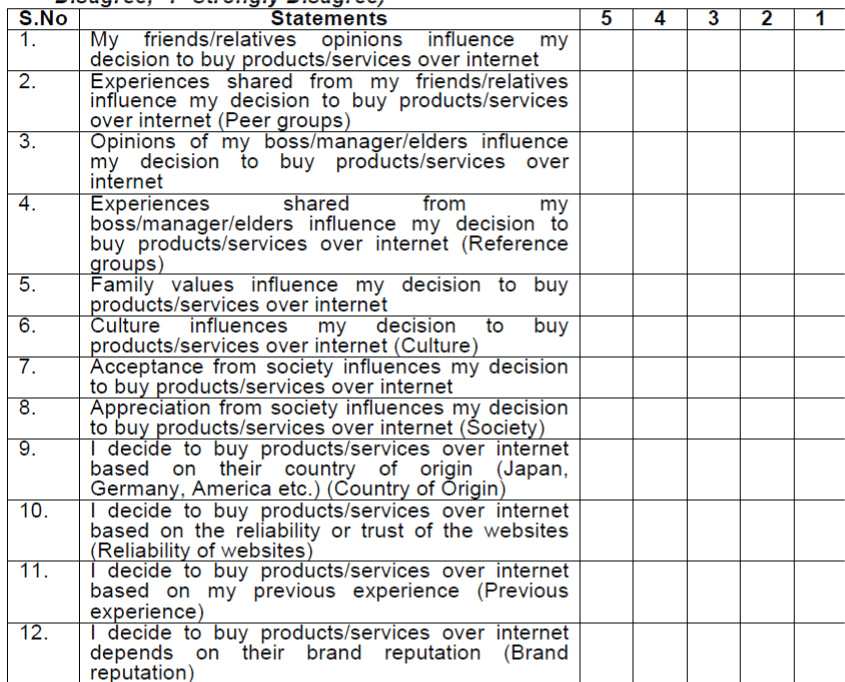 |
Collection Tool (Arabic)
|
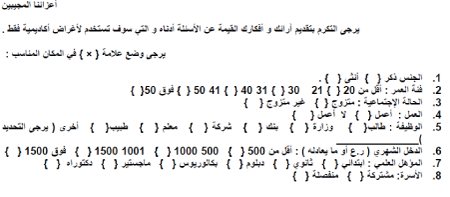 |
 |
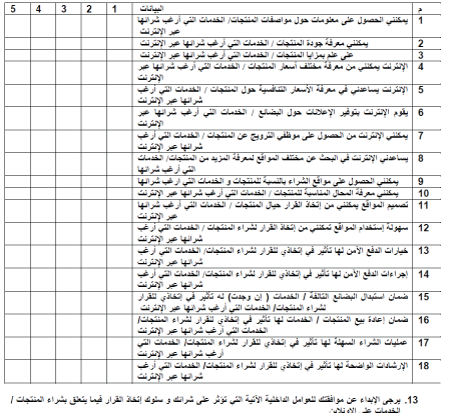 |
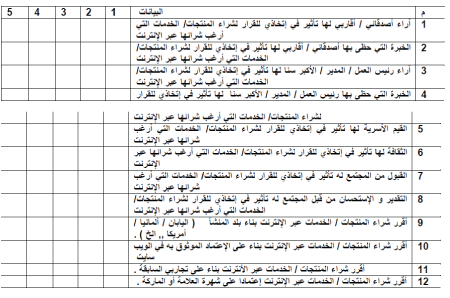 |
| |
Tables at a glance
|
 |
 |
 |
 |
 |
| Table 1 |
Table 2 |
Table 3 |
Table 4 |
Table 5 |
|
| |
Figures at a glance
|
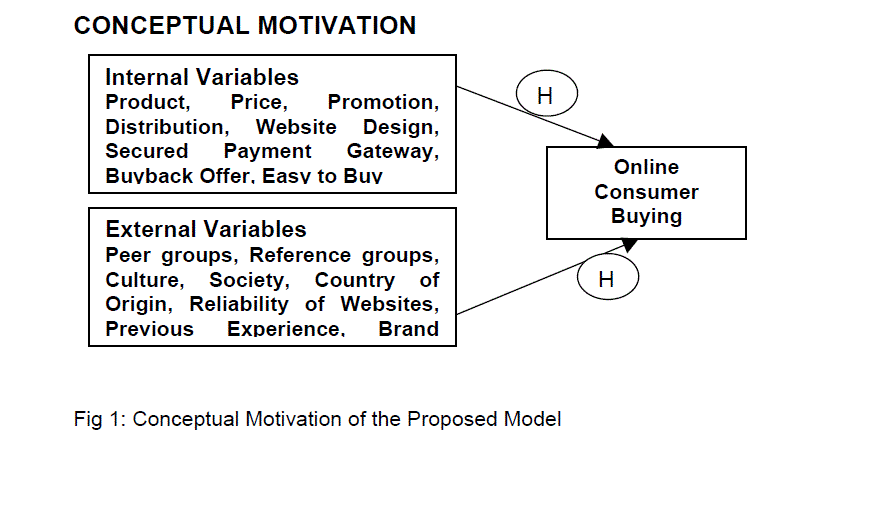 |
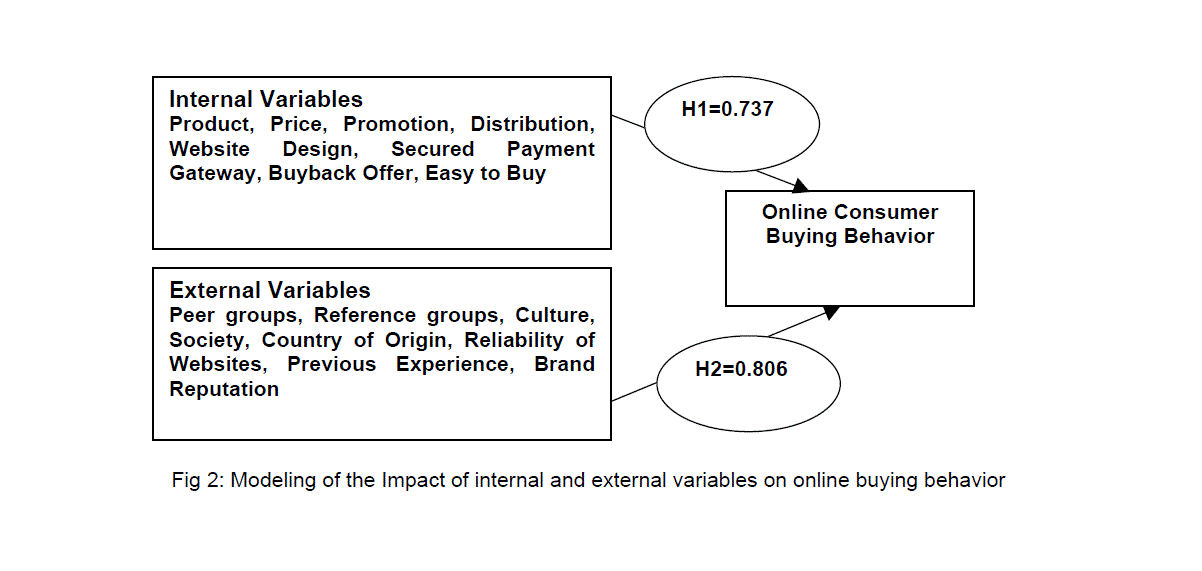 |
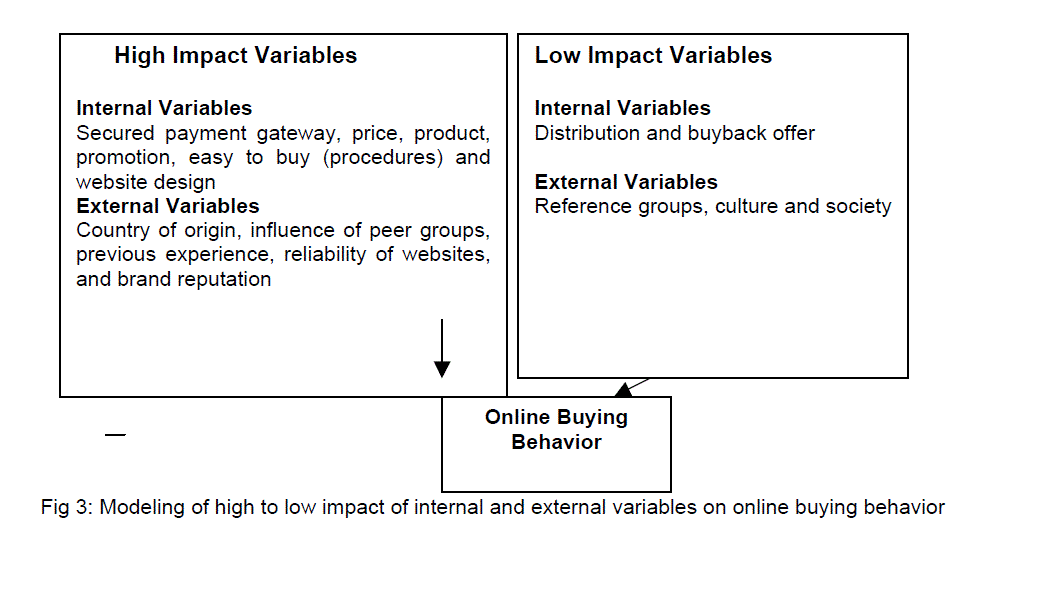 |
| Figure 1 |
Figure 2 |
Figure 3 |
|
| |
References
|
- Aldridge, A., Forcht, K. and Pierson, J, “Get linked or get lost: Marketing strategy for the Internet”, Internet Research, Vol.7, No. : 161-169, 1997.
- Brown, Mark., Pope, Nigel., and Voges, Kevin, “Buying or Browsing?: An Exploration on Shopping Orientations and Online Purchase Intention”, European Journal ofMarketing, Vol.37. No.11/12: 1666-1684, 2003.
- Bosnjak, M., and Galesic, M, “Personality Determinants of Online Shopping: Explaining Online Purchase Intentions Using a Hierarchical Approach”, Journal of BusinessResearch, Vol.60, No.6: 597-605, 2007.
- Bruno, L, “working the web”, Data Communications, Vol.26, No.5: 7-9, 1997. Brunelle, Eric, “Introducing Media Richness into an Integrated Model of Consumers’ Intentions to Use Online Stores in Their Purchase Process”, Journal of InternetCommerce, Vol.8, No. ¾: 222-245, 2009.
- Chevalier, J., and Goolsbee, A, “Measuring Prices and Price Competition Online: Amazon.com and BarnesandNoble.com”, Quantitative Marketing and Economics,Vol.1, No.2: 203-222, 2003.
- Cowles, Deborah. and Kiecker, Pamela, “Developing New Theoretical Perspectives or Predicting Consumer Acceptance and Use of the Internet”,. Proceedings of American Marketing Association Winter Educators Conference, 43-50, 2000.
- Degeratu, A M., Rangaswamy, A., and Wu, J, “Consumer Choice Behavior in Online and Traditional Supermarkets: The Effects of Brand Name, Price and Other SearchAttributes”, International Journal of Research in Marketing, Vol.17, No.1: 55-78,2000.
- Dinev, T., Bellotto, M., Hart, P., Russo, V., Serra, I., and Colautti, C, “Privacy Calculus Model in E-commerce – A Study of Italy and the United States”, European Journal of Information Systems, Vol.15: 389-402, 2006.
- Eastlick, Mary A., and Lotz, Sherry, “Profiling Potential Adopters and Non-adopters of Interactive Electronic Shopping Medium”, International Journal of Retail & Distribution Management, Vol.27, No.6: 209-223, 1999.
- Fagerstrom, A., and Ghinea, G, “On the Motivating Impact of Price and Online Recommendations at the Point of Online Purchase”, International Journal of Information Management, Vol.31, No.2: 103-110, 2011.
- Feather, Frank, FutureConsumer.Com, Toronto: Warwick Publishing: 300, 2000. Fong, J., and Burton, S, “Electronic Word-of-Mouth: A Comparison of Stated and Related Behavior on Electronic Discussion Boards”, Journal of InteractiveAdvertising, Vol.6, No.2: 53-62, 2006a.
- Fong, J., and Burton, S, “Online Word-of-Mouth: A Comparison of American and Chinese Discussion boards”, Asia Pacific Journal of Marketing and Logistics, Vol.18, No.2: 146-156, 2006b.
- Furberg, A, “Socio-Cultural Aspects of Prompting Student Reflection in Web-Based Inquiry Learning Environments”, Journal of Computer Assisted Learning, Vol.25,No.4: 397-409, 2009.
- Goldsmith, R.E. and Bridges, E, “E-tailing Versus Retailing: Using Attitudes to Predict Online Buying Behavior”, Quarterly of Electronic Commerce, Vol.1, No.3: 245-253, 2000.
- Goldsmith, R.E, “Using the Domain Specific Innovativeness Scale to identify innovative Internet consumers”, Internet Research: Electronic Networking Applications andPolicy, Vol.11, No.2: 149-158, 2001.JIBC December 2013, Vol. 18, No. 3 - 16
- Goldsmith R. E, “Explaining And Predicting Consumer Intention To Purchase Over the Internet: An Exploratory Study”, Journal of Marketing THEORY & PRACTICE,Spring: 23-38, 2002.
- Gilula, Zvi, McCulloch, Robert E, and Rossi, Peter E, “ A Direct Approach to Data Fusion”, Journal of Marketing Research, Vol.43, No.1: 73-83. 2006.
- Haijden, Hans van der., Verhagen, T., and Creemers, M, “Understanding Online Purchase Intentions: Contributions from Technology and Trust Perspectives”, European Journal of Information Systems, Vol.12: 41-48, 2003.
- Jiang, P., and Rosenbloom, B, “Customer Intention to Return Online: Price Perception, Attribute Level Performance, and Satisfaction Unfolding Overtime”, European Journal of Marketing, Vol.39, No.1/2: 150-174, 2005.
- Karson, E, “Two dimensions of Computer and Internet use: a reliable and validated scale”, Quarterly of Electronic Commerce, Vol.1, No.1: 49-60, 2000.
- Katz, J. and Aspden, P, “Motivations for and barriers to Internet usage: results of a nationalpubic opinion survey”, Internet Research, Vol.7, No.3: 170-188, 1997.
- Kim, E.Y., and Kim, Y-K, “Predicting Online Purchase Intentions for Clothing Products”, European Journal of Marketing, Vol.38, No.7: 883-897, 2004.
- Kozinets, Robert, V, de Valck, Kristine, Wojnicki, Andrea C, and Wilner, Sarah, J.S, “ Networked Narratives: Understanding Word-of-Mouth Marketing in OnlineCommunities”, Journal of Marketing, 74, 2, 2010, 71-89, 2010.
- Kwak, H, Fox, Richard J. and Zinkhan, George, M, “What Products Can Be Successfully Promoted and Sold via the Internet?”, Journal of Advertising Research, Jan-Feb :23-38, 2002.
- Kwak, H, Zinkhan, George, M, Yue, Pan and Andras, Trina, Larsen, “Consumer Communications, Media Use, and Purchases via the Internet: A Comparative,Exploratory Study”, Journal of International Consumer Marketing, Vol.20, No. ¾: 55-68, 2008.
- Lim, K H., Sia, C L., Lee, M K O., and Benbasat, I, “Do I Trust You Online and If So, Will I Buy? An Empirical Study on Two Trust Building Strategies”, Journal of management Information Systems, Vol.23, No.2: 233-266, 2006.
- Modahl, M, Now or Never, New York: Harper Business, 2000.
- Moon, J., Chadee, D., Tikoo, S, “Culture, Product Type, and Price Influences on Consumer Purchase Intention to Buy Personalized Products Online”, Journal of Business Research, Vol.61, No.1: 31-39, 2008.
- Murphy, Tom, Web Rules: How the Internet is Changing the Way Consumers Make Choices. Chicago: Dearborn Financial Publishing, 2000.
- Novak, Thomas P., Donna, L. Hoffman. andYiu-Fai, Yung, “Measuring the Customer Experience in Online Environments: A Structural Modeling Approach”, Marketingcience, Vol.19, No.1: 22-42, 2002.
- Peterson, Robert A., Balasubramaniam, Sridhar, and Bronnenberg, BartJ, “Exploring the implications of the Internet for Consumer Marketing”, Journal of the Academy of Marketing science, Vol.25, No.4: 329-346, 1997.
- Sakkthivel, A.M, “E-commerce in the Millennium – Shifting Paradigms”, South AsianJournal of Management, Vol. 9, No.4: 2002
- Sakkthivel, A M, “Impact of Demographics on consuming different online services”, Journal of Internet Banking and Commerce (JIBC), Vol.11, No.3, December :2006 http://www.arraydev.com/commerce/jibc/current.asp
- Sakkthivel, A.M, “Impact of Demographics on Online Buying Behavior towards Different Products”, International Journal of Electronic Finance, Vol.3, No.3: 284-296,JIBC December 2013, Vol. 18, No. 3 - 17 -2009
- Sakkthivel, A M, “Influence of Internet on Online Buyer Involvement towards Buying Different Products and Services”, International Journal of Electronic Finance, Vol. 4, No.2: 171-189, 2010.
- Sakkthivel, A M, “Modeling of Determinants Influence Consumer Behavior towards Different Technology Products”, International Journal of Electronic Finance,Vol.5, No.1:-103, 2011b.
- Sakkthivel A M and Sriram B, “Modeling the Impact of Marketing Information on Consumer Buying Behavior in a Matured Marketing Environment: An Exploratory of the Middle East Consumers”, Journal of Promotion Management , 2012 * (InPress),
- Seckler, V, “Survey Says Web apparel buys doubled”, Women’s Wear Daily: 2, 12 July 2000.
- Solo, J., and Karjaluoto, H, “A Conceptual Model of Trust in the Online Environment”, Online Information Review, Vol.31, No.5: 604-621, 2007.
- Tan, F B., Yan, L., and Urquhart, C, “The Effect of Culture Differences on Attitude, Peer Influence, External Influence and Self Efficacy in Actual Online ShoppinBehavior”, Journal of Information Science and Technology, Vol.4, No.1:1-23, 2007
- Thompson, S.H. T, and Yuanyou, Y, “Online Buying Behavior: a Transaction Cost Economics Perspective”, Omega, Vol.33, No.5: 451-465, 2005.Taylor Nelson Sofres Interactive Global e-commerce Report: 1-279, 2002.
- UCLA Internet Report, “Surveying the Digital Future” http://www.ccp.ucla.edu, 2000.
- UCLA Internet Report, “Surveying the Digital Future” http://www.ccp.ucla.edu, 2001.
- UCLA Internet Report, “Surveying the Digital Future” http://www.ccp.ucla.edu, 2003.
- Wysocki, B, “Need for profits the dot-coms’options”, Wall Street Journal: P. A1, 1 May 2000.
- Zhou, L., Dai, L., and Zhang, D, “Online Shopping Acceptance Model – A Critical Survey of Consumer Factors in Online Shopping”, Journal of Electronic CommerceResearch, Vol.8, No.1: 1-22,
|